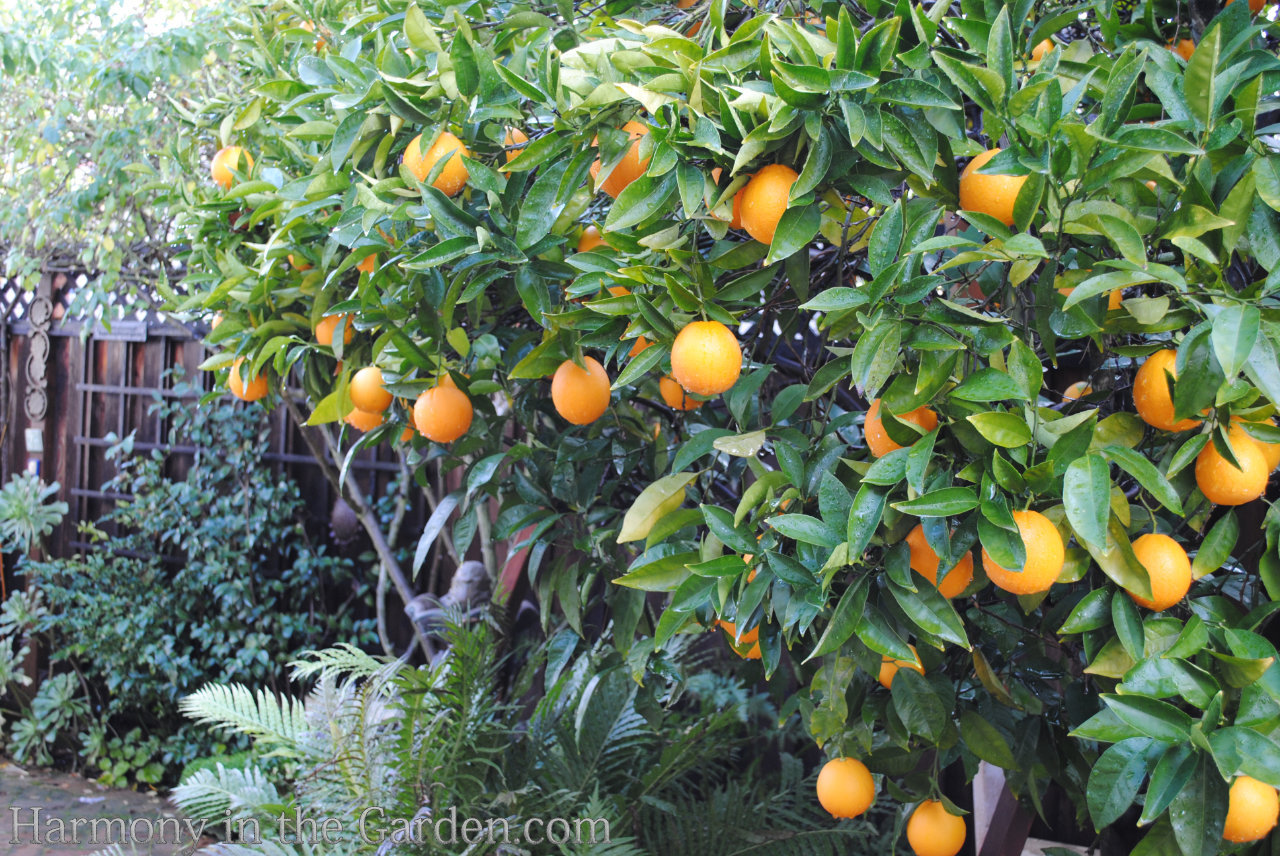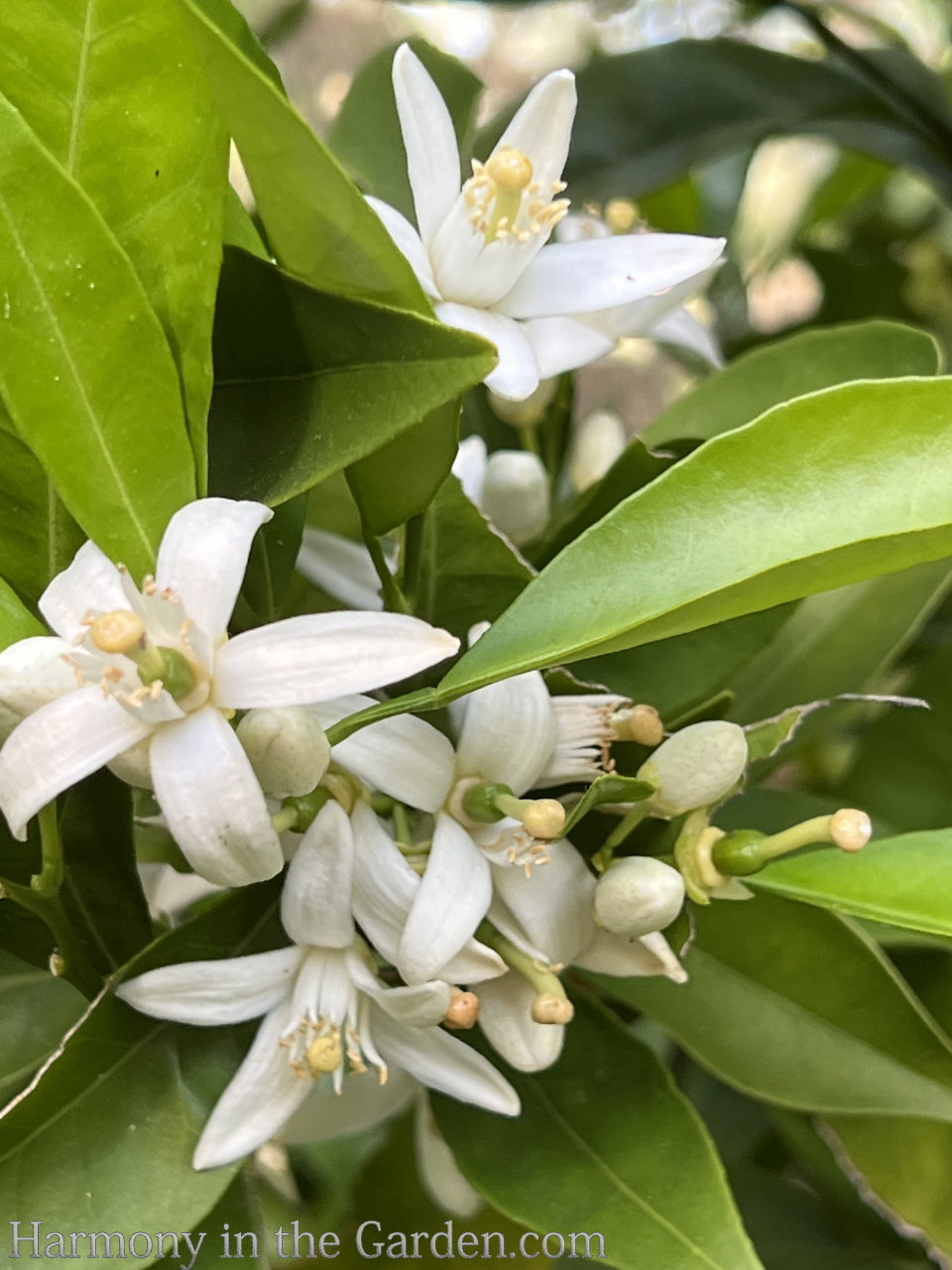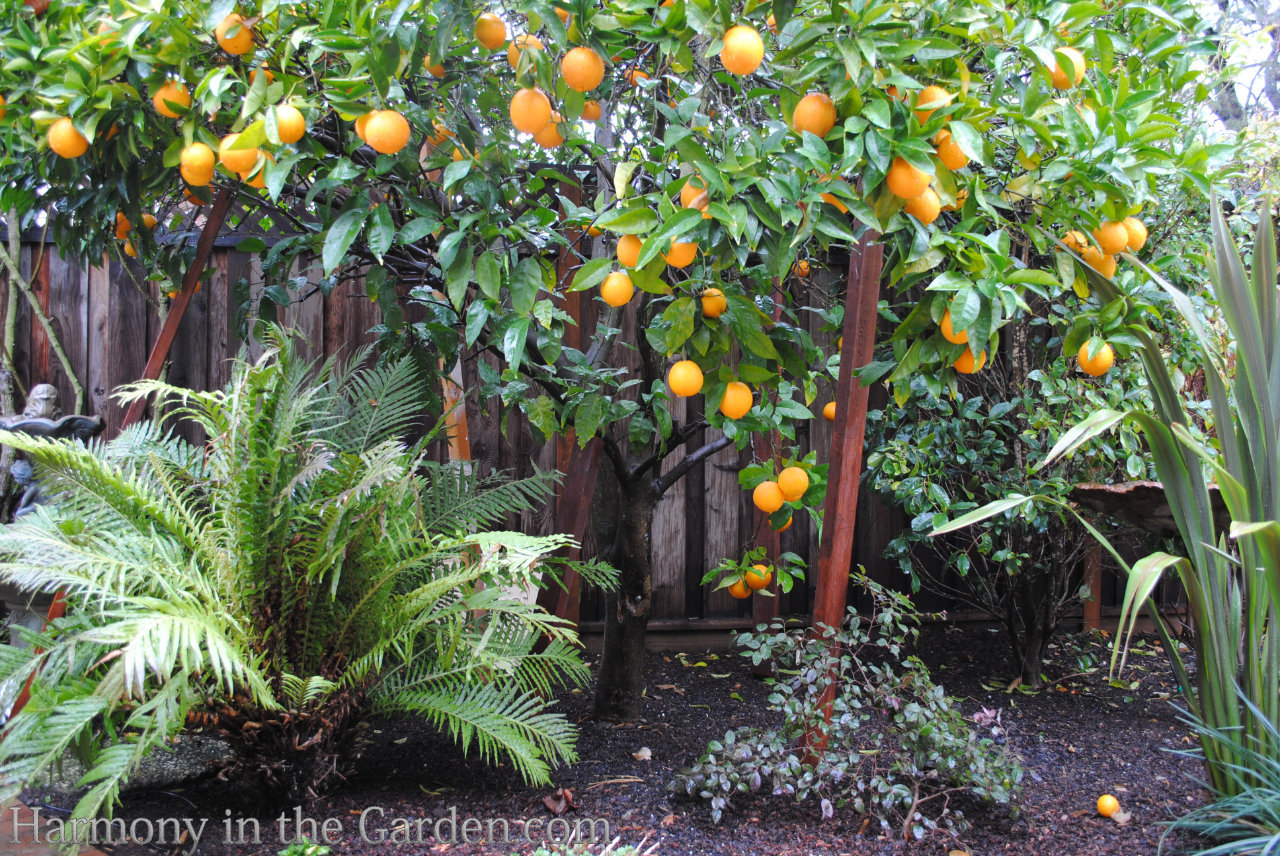
Meet Frankenstein, my wind-damaged ‘Washington Naval’ orange tree!
It’s January here in Northern California and today I ate the first orange off my beloved orange tree.
I love that first, sweet-with-a-hint-of-sour-taste from the season’s first fruit.
I look forward to it all year, beginning in late spring when my garden is blanketed with the scent of its heavenly blossoms.
Then again in the fall with its swelling green ‘tennis-balls’, and then again in late winter, when my dreary winter garden is punctuated with bright orange balls of color.

‘Washington Naval’ is the variety I recommend for my clients, as the fruit ripens in the late winter (in contrast to a Valencia orange which ripens in the summer).
Personally, I’d much rather have something delicious to eat from my garden in January, when there’s not a whole lot going on, versus Summer’s overwhelming abundance of fruit.
Plus, eating fresh fruit from your garden in the winter seems just a little bit more exciting.
But beware!
All citrus needs to be protected from freezing temperatures, which seem to be occurring here with more and more consistency.
Unusually cold temps in the mid-twenties can severely damage or possibly ruin an entire crop.
Luckily, it seems that once the tree has a few years under its belt it tends to survive the freezes with little damage.

When your tree is young, though, pay close attention to the weather reports and if a hard freeze is coming make sure you cover your tree with burlap.
You can also wind old-fashioned Christmas lights throughout the inside of the tree (yes, they’ll provide a little heat to help stave off damage.)
Also, once your tree is heavy with fruit pay close attention to unexpected strong winds and heavy rain which can weigh down your tree and cause it to split in half.
When a storm is coming, make sure to prop up its limbs (I use several strategically placed 2×4’s.)

One fateful winter, I completely forgot to prop up the branches of my tree and watched in horror as 50 MPH winds ripped through my garden.
The wind split my tree down the middle – TWELVE INCHES FROM THE GROUND! I kid you not.
I was frantic, as this tree is such an important part of my garden not only because I love the fruit, but because it blocks an unsightly view of my neighbor’s roofline.

It would take me years to get another tree to grow to that size again!
My neighbors helped to hoist the tree back together, pulling it with a winch (that’s how heavy it was!) and we bolted the trunk together ‘Frankenstein-style’.
I was skeptical, to say the least, that my bolted tree would survive this terrible wound – but you know what? It worked!
This tree SHOWED NO SIGNS OF TRAUMA-EVER! No wilting, no pouting, no dropping its leaves – nothing!
Well, not exactly.
The following year, it never set fruit. Instead, it focused it’s energy on healing itself. However, the next year we were back in business with a tree full of oranges.
Since then, I’ve since had several tree experts tell me that citrus trees are some of the most resilient around.
Every winter, since that fateful storm, I look at its branches once again weighted down with glorious fruit and am amazed all over again by its unbelievable endurance.
For more reading about citrus trees, click here for some freaky looking lemons!






19 Comments
that is amazing! I love that story of this amazing orange tree. We had a fantastic orange tree in Phoenix that sounds like this one. How I loved the first firm oranges with their slightly sour sweetness. My mouth is puckering as I write this…..
I have memories of a childhood visit to orange county Ca to visit my aunt and cousins, – my teenage cousin took us scrumping in orange orchards behind their new house which were just about to be pulled down. I remember the wonderful taste (and being afraid that i’d fall down a crack in the earth if there was an earthquake!)
Oh Rebecca, your garden (and the oranges) look delectable. Our tree is loaded too and I never take those golden gems for granted. I consider it the greatest pleasure to feast on a freshly picked one every morning (and hopefully for a few months).
Sending love from my sunny garden to yours,
Sharon Lovejoy Writes from Sunflower House and a Little Green Island
Does this make you the Bride of Frankenstein?
haha! I guess, in a way, yeah! I definitely have the hair for that role!
Amazing! I would have thought the damage was too severe for the plant to stay alive.
Fern, Susie, Christia and Laura – I agree – the fact that this tree took ‘such a hit’ and wasn’t even phased is amazing…I tell everyone I know about this so the next time their tree suffers in a storm, they’re not so quick to rip it out!
So so so not fair!! The oranges, the tulips, the sun – beautiful! Clearly a result of your gardening talents and lovely warm part of the world.
Thanks.. 😉
I love the first photo that shows the clever way you have echoed the color of the orange fruit with the adjacent tulip planting. Bravo!
And yes, I’m *totally* jealous of your January crop of citrus!
Thanks – I love planting the tulips under the tree – some years they’re orange, some years they’re purple….I think I like the orange ones best, tho…
I can’t believe that did the trick! Thank goodness for old remedies, your tree looks beautiful!
Pretty studly orange tree you have there. We sure love ours, though it’s only a young 20 or so years old. Sure is productive as heck, with almost no care at all.
Wow, that’s some street cred right there. Way to go orange tree! And fabulous idea to “stitch” him back together.
Wow, that’s some street cred right there. Way to go orange tree! And fabulous idea to “stich” him back together.
We are near Cape Town in South Africa. Our next town is called Citrusdal, for obvious reasons. Have just planted 2 orange trees. One is called Washington. Do you know the source of the name?
Great to hear from you! This is what I’ve found out on the internet….”Washington navel orange, is also known as the Bahia for the Brazilian city from which it was imported into the United States in 1870. Although its origins are uncertain, it is believed to come from a bud sport found in a Selecta orange tree in the early 1800s. Upon its arrival at the U.S. Department of Agriculture in Washington, D.C. it was propagated and trees were sent to California and Florida. Although the Florida trees did not flourish, those sent to Eliza Tibbets in Riverside, California found an ideal climate for their culture. These exceptionally delicious, seedless, easy-peeling fruits quickly attracted the attention of citrus growers, and within a decade the “Washington” navel orange, as it came to be known, was the most widely planted variety in the area.”
I hope that helps – best of luck with your trees…..
Was that the New Year’s storm 06? That was a doozy! Love your Frankenstein fix! My parents have a similarly venerable tree in their yard, must be close to 50 years old; definitely part of the family! Thanks!
Wow, that is very cool. Obviously we don’t grow citrus here other than the occasional Lemon or Limes, that have to be indoor for a part of the year AND hand pollinated. So to see this is a treat! Luck you.
Also, the Frankenstein treatment is great. I never would have thought it could handle that!